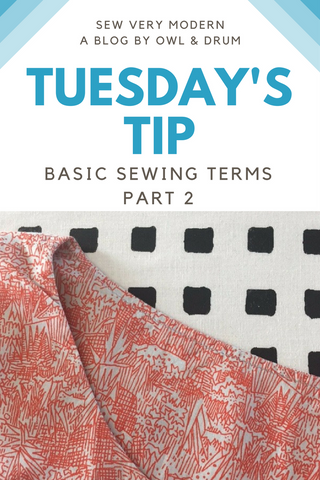Tuesday's Tip - Basic Sewing Terms Part 2
Posted by Bianca Howell on

Welcome to another installment of Sew Very Modern's Tuesday's Tip! This week we will focus on some more sewing terms that may not be self explanatory. It is so useful to be familiar with these terms, especially for all of the self learners out there.
Back Stitch - as used in sewing, is the initial and final step when hand-stitching or sewing on a sewing machine. After a couple stitches, do a couple of reverse stitches. This reinforces your stitches and prevents your seams from falling apart.
Cross Grain - also called the "bias," the cross grain runs diagonally across the grain of fabric. While this term is used predominantly in the UK, it is useful to know because a lot of the patterns we use these days are written by UK designers.
Edge Stitch - a finishing stitch sewn very close to the seam on the right side of the fabric.
Knit Fabric - a material that is comprised of interlaced loops. Knit fabric is a stretchy and flexible fabric and can be either a jersey or interlock knit.
Notch - found in sewing patterns, notches are the triangles found on a pattern that are used to make sure two pattern pieces match up against each other. When properly aligned and sewn, the two pieces of your fabric will come together correctly as per the pattern.
Raw Edge - the edge of the fabric where the loose ends are sticking out. To prevent fraying from the raw edge, you can use a serger to finish your seams or a variety of finishing stitches - such as a zig zag stitch or mock overlock stitch.
Right Side/Wrong Side - these terms are used when speaking about the fabric. The "right side" of the fabric will be what is shown on the outside of your sewn piece. While the "wrong side" of the fabric is on the inside of your sewn piece.
Stay Stitch - a single line of stitching usually done on a curve of one layer of fabric. It is used to act as a stabilizer to keep your fabric from becoming distorted or stretched.
Under Stitch - a single line of stitching sewn along the edge of facing to keep the fabric from rolling. The under stitch is usually sewn along a neckline or armholes.
Woven Fabric - made up from warp and weft threads, woven fabric is a textile that is formed from weaving. The weaving process comes from interlacing two or more threads at right angles to on another. Examples of woven fabrics include quilting cottons, flannels, lawns, and rayons.
Thanks so much for reading our latest edition of Tuesday's Tip - we hope you found it informative and helpful! Sew Very Modern and Owl & Drum's blog are always looking to share ideas.
Keep a lookout for more news, profiles and features in 2018! We have a lot of fun stories to share. Also, Owl & Drum is happy to announce we will be hosting numerous special events and pop-up shops starting in the New Year. Thanks again . . . and keep on sewing!
